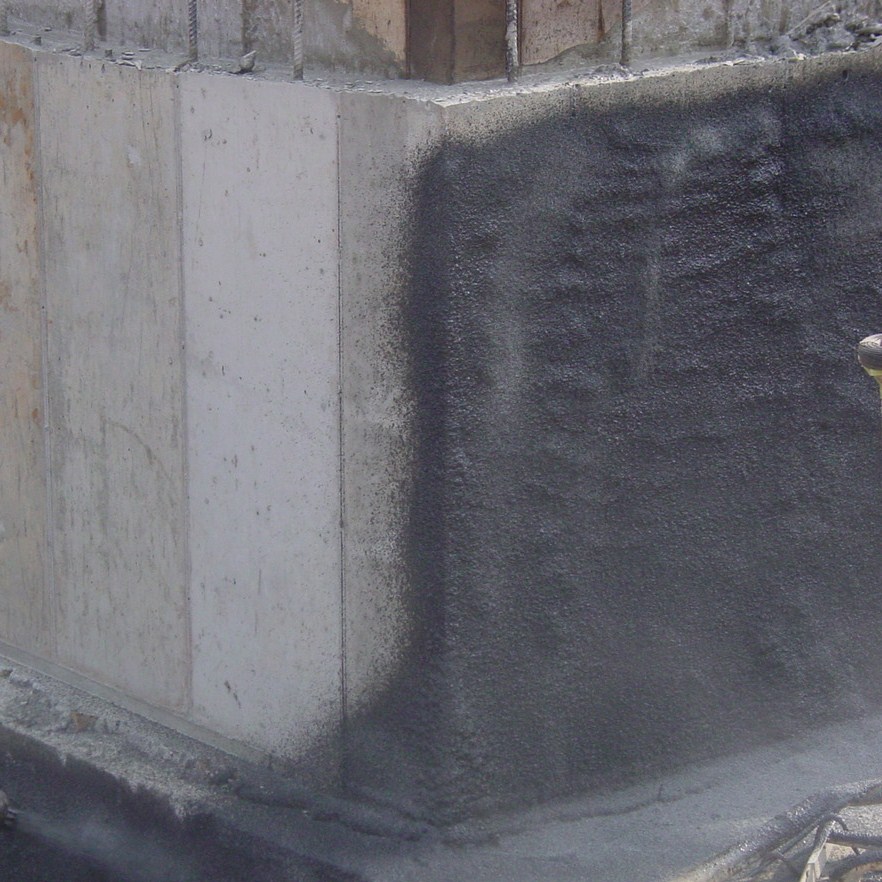Bentonite Waterproofing
Bentonite is a type of clay having the unusual characteristics of cohesion, binding, sealing, and thickening. It is usually gray in color and when processed has the consistency of fine powder, similar to cement or flour. When bentonite is installed below grade as a waterproofing membrane, it becomes hydrated with the moisture that is naturally present in the soil and forms an impermeable barrier that absorbs and expels water and most chemicals, such as acids and salts (sodium bentonite). Bentonite can expand and contract an infinite number of times and is capable of absorbing seven to 10 times its own weight in water, swelling up to 18 times its dry volume. However, for bentonite to function properly as a waterproofing barrier, it is extremely important that this barrier remain under a constant minimum pressure of 30 to 60 pounds per square foot (PSF).
 Credit: DRI-LOK Corporation
Credit: DRI-LOK Corporation
Topic Summary
Bentonite clay flakes can have varying chemical compositions. The types of bentonite available consist of sodium, calcium, magnesium, and sometimes hydrogen. Two of the more common types used in the construction industry are sodium and calcium, with sodium bentonite having the highest rate of expansion and providing the best waterproofing material. Sodium bentonite is a unique mineral formed from volcanic ash and salt water. It is a natural mineral that is inorganic and nontoxic. The primary source of sodium bentonite is the Black Hills region of the U.S., which extends across parts of Wyoming, Montana, and South Dakota. The mined clay is ground up and its moisture content is reduced to around 10 percent by drying in large kilns. It is then ground more finely to pass through industry-standard sieve sizes ranging from 40 to 200 mesh.
Bentonite was first used to help seal earth dams and line ponds in the late 1920ís. After that, bentonite was used as a lubricant for driving pilings and caissons. In the mid-1960ís bentonite became accepted as a below-grade waterproofing membrane for the building construction industry.
Bentonite Waterproofing Design Basics
- Bentonite can be used under structural or non-structural concrete floor slabs,
- On below-grade foundation walls,
- Between slab applications,
- Under slab applications,
- For zero property line construction, and
- Along tunnels and subway walls.
For deep foundations, especially in locations where crowded conditions prevent the extensive excavation that would be required for traditional waterproofing techniques, blindside waterproofing can be used. Blindside waterproofing is installed before the structural member is put in place. Because it significantly reduces the footprint of a building, blindside waterproofing can help achieve LEED prerequisites or credits for Sustainable Sites Initiative Site Development. Bentonite is commonly used for blindside applications, because it has the ability to repair itself if ripped, punctured, or cracked.

Types of Bentonite Waterproofing
- Unaltered high-swelling sodium bentonite mixed with sand, which is only usable for horizontal applications such as a water-containment membrane in stock ponds, sewer lagoons, landfills, irrigation canals and cut-off walls, and decorative garden ponds.
- Geotextile bentonite waterproofing sheets consisting of 1 PSF of bentonite clay granules between two layers of geotextile polypropylene fabric, one woven and one nonwoven, needle punched and heat fused together. This type of bentonite waterproofing is used for below-grade slabs and vertical walls and as a blindside waterproofing membrane.
- Bentonite waterproofing panels consisting of approximately 1 PSF of bentonite clay granules confined in the corrugations of kraft-paper boards, used for waterproofing split-slab construction, backfilled concrete and masonry walls, and earth-covered structures. Bentonite panels can also be used for blindside waterproofing.
- Composite geotextile high-density polyethylene (HDPE) sheets and panels consist of bentonite clay granules bonded to a geotextile fabric with HDPE bonded to the surface of the fabric or panel.
- Spray-applied bentonite waterproofing membrane is either combined with an asphalt binder or is polymer-enhanced. This type consists of Wyoming type bentonite with an elasticized binder and is used for below-grade slabs and vertical walls. It is also excellent for complex shoring systems with irregular shapes and objects such as tiebacks and rakers.
- Trowel grade bentonite comes in the form of a mastic that is trowelable. It is specifically used for application at joints and penetrations.

Buildipedia Staff
The Buildipedia research and writing staff consists of dozens of experienced professionals from many sectors of the industry, including architects, designers, contractors, and engineers.
Website: buildipedia.com/


